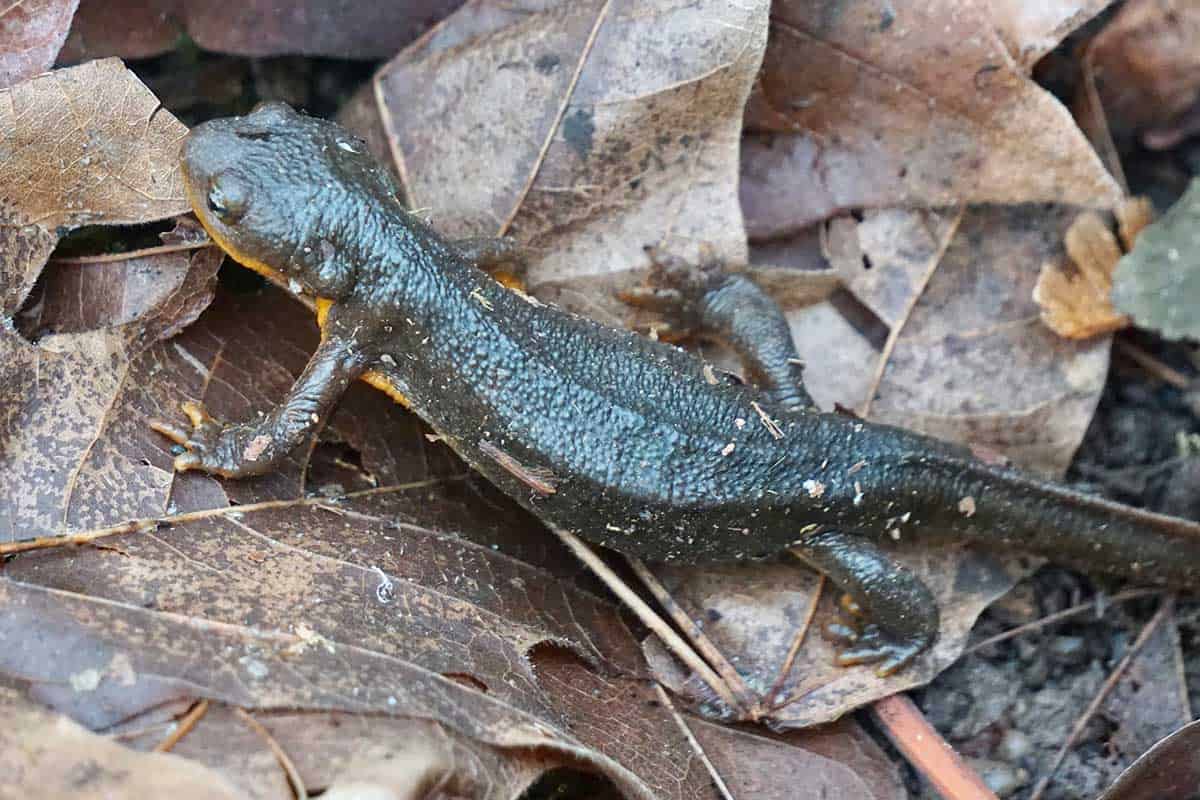Salamanders are a vital part of the ecosystem and play a critical role in keeping it healthy. And with over 9 different species of Salamanders in Oregon, there are plenty of opportunities to see these fascinating creatures!l
You can often find them near water and moist areas, especially in damp forests and wetlands. While they’re often thought of as one of the most innocuous creatures that scurry around in the woods, these little amphibians play a vital role in the ecosystem.
They control insect populations, and their burrowing habits help aerate the soil in Oregon forests.
Salamanders in Oregon
Salamanders have been around for millions of years and are one of the oldest groups of amphibians. Some of these creatures are quite beautiful, while others are quite strange looking. In this blog post, we will take a closer look at the nine different species of salamander that call Oregon home:
1. Blotched tiger salamander
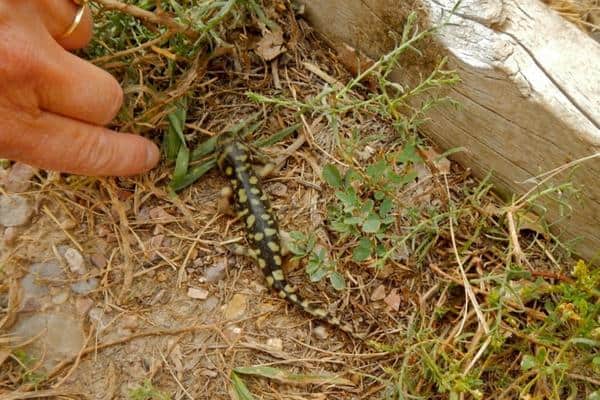
Scientific Name: Ambystoma mavortium
The blotched tiger salamander is one of Oregon’s most unique and beautiful salamanders. It gets its name from the large, dark spots that cover its body. These salamanders are usually a dark brown or black color, with some shades of gray mixed in.
The Blotched Tiger Salamander is one of the largest Salamanders in Oregon and can grow over a foot long! These salamanders are nocturnal, so they are mostly active at night. During the day, they hide under rocks or logs and are found in the Willamette Valley and Cascade Mountains of Oregon.
This Salamander prefers to live in forested areas near ponds, lakes, or streams. It eats a variety of insects, spiders, and other small invertebrates.
2. Northwestern Salamander

Scientific Name: Ambystoma gracile
The northwestern salamander is one of the most common salamander species in Oregon. They have solid-brown smooth skin that is sometimes mottled with darker brown spots. The ventral or underside of their tail is usually lighter in color. They have a distinct head shape with a rounded snout.
This salamander species can grow about 6-10 inches long. Most of their diet consists of insects and other small invertebrates. They are found in various habitats, including forests, woodlands, and meadows. It’s rare to see adult northwestern salamanders because they live underground in rodent burrows.
The northwestern salamander is active year-round but is most often seen during the fall and spring. They are mostly nocturnal but can be found basking in the sun on cool days.
Some of the best places to find them are in the Willamette Valley, the Coast Range, and the Cascade Mountains. However, they can also be found in many other parts of Oregon.
3. Cope’s Giant Salamander
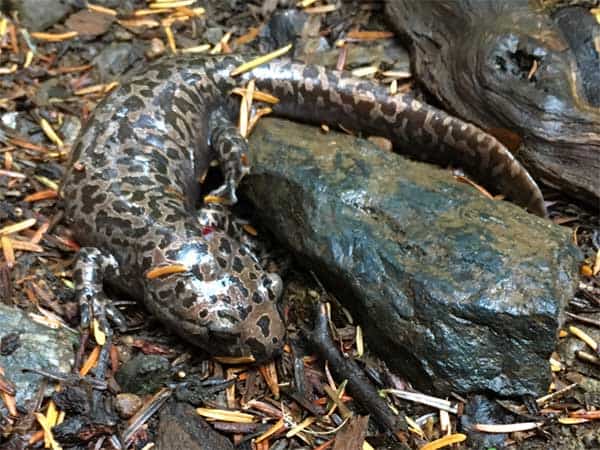
Scientific Name: Dicamptodon copei
Cope’s giant salamander can grow up to two feet in length and is typically a marble-brown, tan, or black color. They also have yellowish-tan spots on their skin, especially during their land-living stage, which is rare in adulthood.
These giant salamanders have both aquatic and terrestrial stages, and the adults can grow up to 8 inches long from head to tail. Although rare, the terrestrial adult cope’s giant salamanders often have shorter legs and narrower heads than their aquatic counterparts.
This species of salamander lives in fast-flowing, extremely cold, and permanent rivers and streams in evergreen, coniferous forests. On the other hand, adult salamanders live near small rocks and cobbles to search for food and hide from predators.
You can find these salamander species in the East Cascades, the Coast Range, and the West Cascades ecoregions in Oregon.
4. Columbia Torrent Salamander

Scientific Name: Rhyacotriton kezeri
The Columbia torrent salamander is a smaller species that grows up to 4 inches in length. It’s gray, solid green, or brown on the sides with orange or bright yellow undersides.
These salamanders live near cold, clear water streams, especially near waterfalls, springheads, mountainous regions, and seeps in forests. They use the gravel on the waterbody’s bed for foraging and hiding from predators. However, they also jump into the woods during heavy rainfall to avoid being carried away by strong currents.
You can find the Columbia torrent salamander in the Willamette Valley and Coast Range ecoregions.
5. Larch Mountain salamander
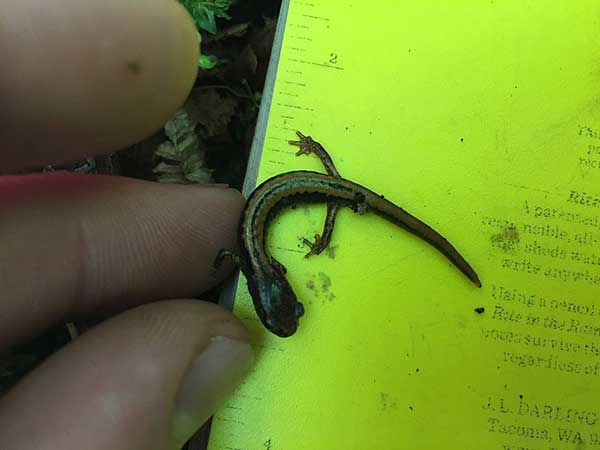
Scientific Name: Plethodon larselli
Larch Mountain salamanders are among the rarest salamander species in the Pacific Northwest. These tiny-bodied woodland amphibians have a pink underside with yellow or reddish-brown dark-spotted stripes running along their backs.
The larch mountain salamander is lungless; it breaths through the skin. The mature adults grow up to four inches long, and the juveniles are about half that size.
Salamanders of this species have a lifespan of about eight years. They like staying in steep piles of volcanic rock fragments and forested areas. That’s because the trees and shrubs in forests block out sunlight, creating a conducive environment for moss to grow. The moss keeps the ground moist and damp all year round.
Larch Mountain salamanders adore slopes covered in tiny twigs, moss, and rotting leaves. The Columbia River Gorge National Scenic area is the major habitat for this species.
6. Long-Toed Salamander
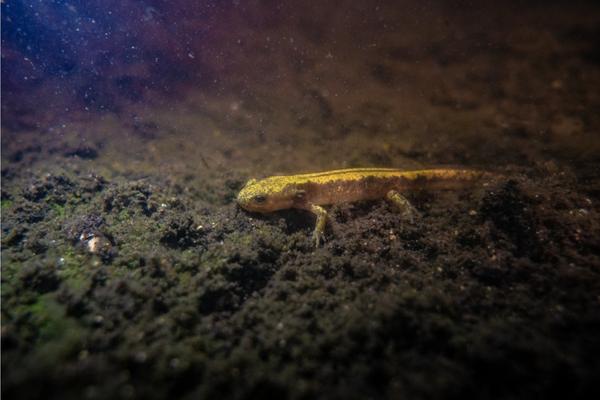
Scientific Name: Ambystoma macrodactylum
The long-toed salamander is native to the western United States and Canada. In Oregon, they can be found in the Cascade Range, the Siskiyou Mountains, and the Willamette Valley. They are carnivores, and their diet consists of small invertebrates, such as insects, worms, and spiders. They get their name from their long toes, which help them climb trees and swim through water.
Adult long-toed salamanders have brown or black skin with a yellow ragged-edged stripe that runs from the top of its head to the tip of its tail. It is flecked with silver or white dots on both sides and the underbelly. Adults may reach up to 6 inches in length overall.
7. Coastal Giant Salamander

Scientific Name: Dicamptodon tenebrosus
The coastal giant salamanders are among the largest salamanders in Oregon. An adult coastal giant salamander can grow up to 14 inches from head to tail.
Terrestrial coastal giant salamanders’ bodies are marble with a shade of brown and tan on their underbellies. The larvae are characterized by their large brown heads, tail fins, and frilled gills.
This species nests in dense, moist, and wet forests near clear streams of cold water, ponds, and lakes. Terrestrial coastal giant salamanders spend most of their time undergrown in burrows. However, you can often see them on the forest floor during heavy rainfall when their underground burrows are flooded.
8. Cascade Torrent Salamander
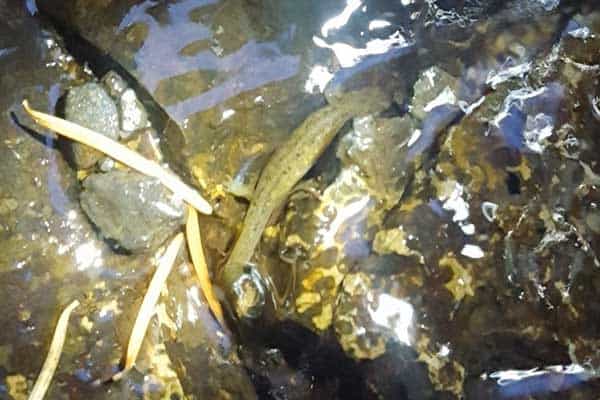
Scientific Name: Rhyacotriton cascadae
Cascade torrent salamanders are characterized by their many medium-sized silver-gray flicking and black spots along their brown, tan sides and back. They also have orange to bright yellow undersides with smaller dark spots.
The adults grow to about 4 inches in length. Cascade torrent Salamanders live in the same habitat as the coastal giant salamander but can also be found near waterfalls and other high-velocity water sources.
Both adults and larvae of this species are predators and eat a variety of insects, spiders, and other invertebrates. Larvae will often attach themselves to the back of an adult until they metamorphose into their adult form. You can find these salamanders throughout Oregon, but they are most commonly found in the Willamette Valley and along the coast.
9. Rough-Skinned Newt
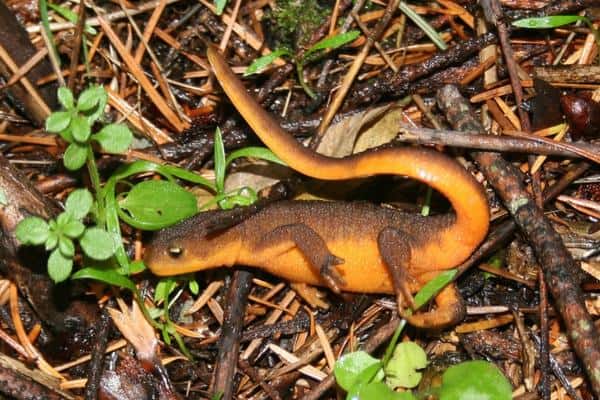
Scientific Name: Taricha granulosa
Rough-skinned newts have dry-granular skin, which is poisonous to predators. The newts secrete a poison from their skin that is so potent that it has been known to kill humans.
The adults can grow up to five inches in length and are usually dark brown or olive green on their backs with a yellow or orange underside. Rough-skinned newts have three rows of large spots down their backs and sides. The larvae are characterized by their small black eyes, long tail, and large head.
Rough-skinned newts live near slow-moving water sources such as ponds, lakes, and marshes. You can find them throughout Oregon, but especially in forested areas near the coast and throughout the eastern foothills of the Cascades.
